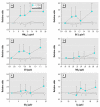Association of air pollution with increased incidence of ventricular tachyarrhythmias recorded by implanted cardioverter defibrillators
- PMID: 15929887
- PMCID: PMC1257589
- DOI: 10.1289/ehp.7767
Association of air pollution with increased incidence of ventricular tachyarrhythmias recorded by implanted cardioverter defibrillators
Abstract
Epidemiologic studies have demonstrated a consistent link between sudden cardiac deaths and particulate air pollution. We used implanted cardioverter defibrillator (ICD) records of ventricular tachyarrhythmias to assess the role of air pollution as a trigger of these potentially life-threatening events. The study cohort consisted of 203 cardiac patients with ICD devices in the Boston metropolitan area who were followed for an average of 3.1 years between 1995 and 2002. Fine particle mass and gaseous air pollution plus temperature and relative humidity were measured on almost all days, and black carbon, sulfate, and particle number on a subset of days. Date, time, and intracardiac electrograms of ICD-detected arrhythmias were downloaded at the patients' regular follow-up visits (about every 3 months). Ventricular tachyarrhythmias were identified by electrophysiologist review. Risk of ventricular arrhythmias associated with air pollution was estimated with logistic regression, adjusting for season, temperature, relative humidity, day of the week, patient, and a recent prior arrhythmia. We found increased risks of ventricular arrhythmias associated with 2-day mean exposure for all air pollutants considered, although these associations were not statistically significant. We found statistically significant associations between air pollution and ventricular arrhythmias for episodes within 3 days of a previous arrhythmia. The associations of ventricular tachyarrhythmias with fine particle mass, carbon monoxide, nitrogen dioxide, and black carbon suggest a link with motor vehicle pollutants. The associations with sulfate suggest a link with stationary fossil fuel combustion sources.
Figures
References
-
- Bayes de Luna A, Coumel P, Leclercq JF. Ambulatory sudden cardiac death: mechanisms of production of fatal arrhythmia on the basis of data from 157 cases. Am Heart J. 1989;117:151–159. - PubMed
-
- Brook RD, Franklin B, Cascio W, Hong Y, Howard G, Lipsett M, et al. Air pollution and cardiovascular disease: a statement for healthcare professionals from the Expert Panel on Population and Prevention Science of the American Heart Association. Circulation. 2004;109:2655–2671. - PubMed
-
- Creason J, Neas L, Walsh D, Williams R, Sheldon L, Liao D, et al. Particulate matter and heart rate variability among elderly retirees: the Baltimore 1998 PM study. J Expo Anal Environ Epidemiol. 2001;11:116–122. - PubMed
-
- Diggle PJ. An approach to the analysis of repeated measurements. Biometrics. 1988;44:959–971. - PubMed
Publication types
MeSH terms
Substances
Grants and funding
LinkOut - more resources
Full Text Sources
Medical


